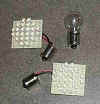LED Lights
LEDs, ("Light Emitting Diode") are
semiconductor diodes that convert applied voltage to light. For
years they have slowly replaced bulbs in many applications like digital
displays and the like. Within the past few years "super
bright" LEDs (as compared to LEDs that have been around for years)
have come to the market and are now starting to replace lights that need
to be bright. Traffic signals and auto taillights are two
examples. The advantages of LEDs is their long life and low voltage
draw.
So, let me think about this, long life and low power
usage..... Sounds like something I want to use when I am dry
camping. Anything that will extend the battery in the pop up is
great for me. The first product I have purchased were replacement
bulbs for my overhead lights. I found these at superbrightleds.com.
|

|
To the left you see two LED lamp
replacement modules for my overhead lights. These are designed
to replace 1156 bulbs and are rated to draw only 85ma (that's milliamps
or .085 amps) This is a great savings over standard bulbs. Now
some pop ups do not have overhead fixtures that take incandescent
1156 bulbs, but have flat wedge base bulbs. The wedge base
style is also available. You will not that the base of
the led lights is on a short wire lead. This allows you to
plug in the bulbs and aim them down. LED lighting is
directional in nature and this system allows these lights use in RV
fixtures. |
|

|
Now, the first problem I had was how to
mount them. They are small rectangular circuit boards with 24 LEDs
on one side and the wiring on the other side. Plus, the light
fixture didn't lend itself to modification. So I used an
old standard in my toolbox "QuickTac", or in this case
"HandiTac". Available at any home improvement store
this stuff is like modeling clay but is used as a glue like
substance. |
|

|
Roll the QuickTac into small balls and
stick them to the back of the lighting units. You can then
stick them to the top of the interior of the light fixtures in the
location the bulb would normally go. Connect the bulb base
into the fixture and you are good to go. |
|

|
Here is what my fixture looks like in
use. The fixtures on the new Niagara have three position
switches; Off, one light on, or two lights on. I replaced the first
bulb to come on with the LED unit so that I could run it
alone. Note that the LED unit (on the right) is not as bright
as the standard incandescent 1156 bulb, but for normal lighting it
works fine. When brighter lighting is needed I just move the
switch to the last position and it turns on the second bulb which is
still an incandescent 1156. |
I added these to all three light fixtures in the 05
Niagara. While they do not provide the light an incandescent 1156
does, for just puttering around the pop up at night they are fine.
When more light is needed we just throw the switch and add the
incandescent 1156s into the mix. This seems to be a great way to
conserve power when dry camping.
MoonBeam Lights
(c)
2003 by Visual Systems & Support Inc.
I was lucky enough to test two sets of MoonBeam Lights which
had been set to Pop Up
Times for review. After Dave tested them, he has let me have them to see how
they work as most of our camping is "dry camping". From the manufacturers
web site they describe them as "MoonBeam Lights are 12-Volt DC, LED
lighting units, originally designed for the Pop-Up Camper. They are an excellent
alternative to the standard, bright and glaring incandescent bulbs found in most
pop-ups and RVs".
They appear to be very sturdily built, but are so light weight
that they can be mounted with Velcro. Each one consists of four LED light
modules, which each module being controlled with its own switch. They plug
directly into the 1/4" power outlets on most pop up lights, so they are
easy to hook up.
They are all custom built, so you can pick the color of LED
(blue, red green amber or white) and if you want the module flush mounted or
mounted on the end of a gooseneck.
 |
To the left you see an entire gooseneck
system. All four modules are at the end of individual
goosenecks so each one can be aimed in a different direction if you
like. |
|
|
| To the right is a all panel mount
system. While this one has four different color LED modules,
you get to choose what color or colors you want. For an all
panel mount system like this I suggest the optional swivel bracket
unless you are only looking for spot light in one area. This
one is mounted directly over the galley in our Niagara. |
 |
|
|
|
I give this product a thumbs up. After using
them on a few camping trips they are nice for spot lighting. I
have one mounted over the galley and using it allows me to make a
midnight snack without waking up the world. The second one
(with the gooseneck heads) is mounted over the dinette table. The
gooseneck allows the light to be directed where needed. |
|